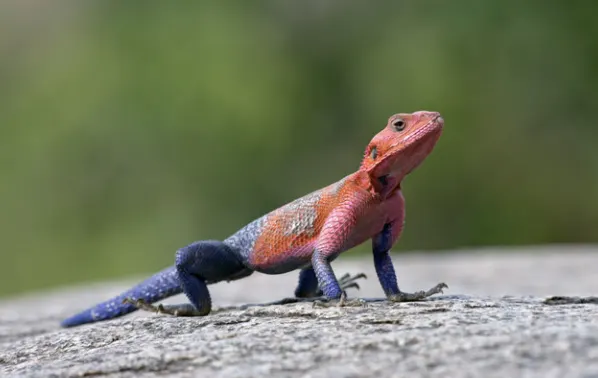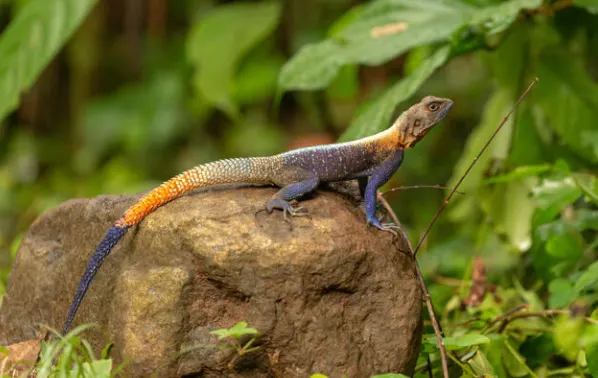The Agama lizard, a fascinating reptile found throughout sub-Saharan Africa, captivates enthusiasts with its vibrant colors and dynamic behaviors. This blog delves into the intricate world of the Agama lizard, exploring its classification, appearance, behavior, habitat, diet, reproduction, and conservation status.
Table of Contents
Scientific Classification and General Information
Belonging to the genus Agama, these lizards are part of the Agamidae family, often referred to as dragon lizards. There are over 40 recognized species within this genus, but the common or red-headed agama (Agama agama) is particularly noteworthy. This lizard’s name is derived from a local West African term meaning “lizard.”

Conservation Status
The Agama lizard is currently classified as Least Concern according to the IUCN Red List. Despite habitat loss posing a threat, these lizards have managed to maintain stable populations due to their adaptability to various environments, including urban areas.
Habitat and Locations
Agama lizards inhabit a diverse range of environments such as forests, deserts, plains, and urban areas across sub-Saharan Africa. Their territories are usually centered around prominent structures like trees or boulders, which the dominant males fiercely defend.
Physical Characteristics
Agama lizards display a striking array of colors and distinctive body shapes, aiding in easy identification. The common agama is characterized by brownish hues with a central light stripe and darker patches along its sides. Dominant males often exhibit vivid blue bodies and yellow heads, while subordinate males and females tend to have olive-green heads. Other notable features include long tails, large heads, external ear openings, and prominent eyelids. These lizards range in size from 12 to 30 cm (5 to 12 inches) and can weigh around 1 kg (2 lbs).
Behavior and Social Structure
Agama lizards live in small social groups led by a dominant male, accompanied by several subordinate males and females. The dominant male, or “cock,” has exclusive breeding rights. These lizards are generally docile but can become aggressive when defending territory or mates. Dominant males often display their bright colors, lash their tails, or engage in head-bobbing displays to ward off intruders. Subordinate males must establish their own territory or challenge the current cock to mate with females.
Diet and Predators
Agama lizards are omnivorous, primarily feeding on insects such as ants, grasshoppers, beetles, and termites. They also consume small mammals, reptiles, flowers, grasses, and fruits. Their powerful jaws and large front teeth allow them to tackle large prey. Natural predators include snakes, birds, and small mammals. Urbanization and pesticide use pose additional threats by disrupting their habitats and
Reproduction and Life Cycle
Breeding typically occurs during the wet season or periods of sufficient rainfall. The lead male initiates courtship with head-bobbing displays. After mating, the female lays a clutch of five to seven eggs in a shallow hole. The eggs hatch in about eight to ten weeks, with hatchlings immediately beginning to forage for
Population and Conservation Efforts
While comprehensive population estimates are lacking, Agama lizards are widespread and common within their natural range. Conservation efforts focus on habitat protection and captive breeding programs, which have been successful in certain regions. Zoos worldwide house Agama lizards in educational exhibits, raising awareness about their conservation needs. Research into their behavior and habitat requirements continues to aid conservation strategies.
Types of Agama Lizards
There are numerous species of Agama lizards, each with unique characteristics. Some notable examples include:
- Ground Agama (Agama aculeata)
- West African rainbow lizard (Agama africana)
- Red-headed rock agama (Agama agama)
- Southern rock agama (Agama atra)
- Mwanza flat-headed rock agama (Agama mwanzae)
These species vary in size, color, and habitat preferences, showcasing the diversity within the Agama genus.
Agama Lizards as Pets
Agama lizards are popular pets due to their striking appearance and relatively easy care requirements. They are suitable for beginner and intermediate reptile enthusiasts. In captivity, they should be housed in enclosures that mimic their natural habitat, with adequate space, temperature regulation, and UVB lighting. A diet of crickets and super worms, supplemented with plant material, ensures their nutritional needs are met.

7 Interesting Facts About Agama Lizards
- Bright Colors Signal Dominance – Dominant male Agama lizards often display vibrant colors, such as blue bodies and yellow or red heads. These striking hues serve as visual signals of their status and play a crucial role in territorial and mating displays.
- Dynamic Social Structure – Agama lizards live in small social groups typically led by a dominant male, known as the “cock,” who has exclusive breeding rights with the females. Subordinate males must establish their own territory or challenge the existing cock to mate.
- Adaptation to Urban Environments – Despite originating in various natural habitats like forests and deserts, Agama lizards have adapted remarkably well to urban and suburban environments. They can often be seen basking on walls, rooftops, and other urban structures.
- Unique Courtship Behavior – Males initiate courtship by performing a distinctive head-bobbing display. This behavior has earned the Agama lizard the nickname “koggelmander” in Afrikaans, meaning “little mocking man.”
- Powerful Jaws and Large Teeth – Agama lizards possess large front teeth and powerful jaws, which are adaptations that enable them to consume large and hard prey items, such as beetles and other tough insects.
- Color Changes Under Stress – When alarmed or agitated, Agama lizards can change color rapidly. This sudden shift to brighter colors can act as a warning signal to potential threats or rivals.
- Extended Lifespan – In captivity, Agama lizards can live up to 25 years, provided they receive proper care. This makes them a long-term commitment for pet owners, requiring consistent habitat maintenance and diet management.
The Agama lizard, with its vibrant colors, intriguing behaviors, and adaptability, is a remarkable reptile species. Understanding its classification, habitat, diet, and social structure enriches our appreciation of this fascinating creature. Conservation efforts remain crucial to ensure the continued survival of these lizards in the wild, safeguarding their place in the rich tapestry of sub-Saharan Africa’s biodiversity.
- Eastern Rat Snake: Nature’s Pest Control and Fascinating Reptile - September 20, 2024
- Eastern Racer: The Fast and Agile Snake - September 19, 2024
- The Eastern Indigo Snake: The Majestic, Non-Venomous Hunter of the Southeast - September 18, 2024
